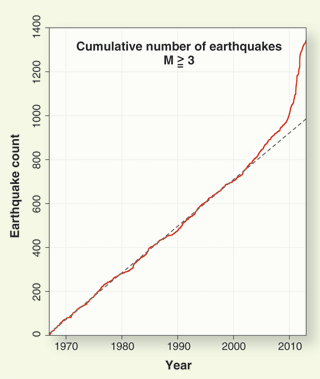Injection-Induced Earthquakes
- E-mail: ellsworth{at}usgs.gov
Structured Abstract
Background
Human-induced earthquakes have become an important topic of political and scientific discussion, owing to the concern that these events may be responsible for widespread damage and an overall increase in seismicity. It has long been known that impoundment of reservoirs, surface and underground mining, withdrawal of fluids and gas from the subsurface, and injection of fluids into underground formations are capable of inducing earthquakes. In particular, earthquakes caused by injection have become a focal point, as new drilling and well-completion technologies enable the extraction of oil and gas from previously unproductive formations.

Earthquakes with magnitude (M) ≥ 3 in the U.S. midcontinent, 1967–2012. After decades of a steady earthquake rate (average of 21 events/year), activity increased starting in 2001 and peaked at 188 earthquakes in 2011. Human-induced earthquakes are suspected to be partially responsible for the increase.
Advances
Microearthquakes (that is, those with magnitudes below 2) are routinely produced as part of the hydraulic fracturing (or “fracking”) process used to stimulate the production of oil, but the process as currently practiced appears to pose a low risk of inducing destructive earthquakes. More than 100,000 wells have been subjected to fracking in recent years, and the largest induced earthquake was magnitude 3.6, which is too small to pose a serious risk. Yet, wastewater disposal by injection into deep wells poses a higher risk, because this practice can induce larger earthquakes. For example, several of the largest earthquakes in the U.S. midcontinent in 2011 and 2012 may have been triggered by nearby disposal wells. The largest of these was a magnitude 5.6 event in central Oklahoma that destroyed 14 homes and injured two people. The mechanism responsible for inducing these events appears to be the well-understood process of weakening a preexisting fault by elevating the fluid pressure. However, only a small fraction of the more than 30,000 wastewater disposal wells appears to be problematic—typically those that dispose of very large volumes of water and/or communicate pressure perturbations directly into basement faults.
Outlook
Injection-induced earthquakes, such as those that struck in 2011, clearly contribute to the seismic hazard. Quantifying their contribution presents difficult challenges that will require new research into the physics of induced earthquakes and the potential for inducing large-magnitude events. The petroleum industry needs clear requirements for operation, regulators must have a solid scientific basis for those requirements, and the public needs assurance that the regulations are sufficient and are being followed. The current regulatory frameworks for wastewater disposal wells were designed to protect potable water sources from contamination and do not address seismic safety. One consequence is that both the quantity and timeliness of information on injection volumes and pressures reported to regulatory agencies are far from ideal for managing earthquake risk from injection activities. In addition, seismic monitoring capabilities in many of the areas in which wastewater injection activities have increased are not capable of detecting small earthquake activity that may presage larger seismic events.
Movers and Shakers
We tend to view earthquakes as unpredictable phenomena caused by naturally shifting stresses in Earth's crust. In reality, however, a range of human activity can also induce earthquakes. Ellsworth (p. 10.1126/science.1225942) reviews the current understanding of the causes and mechanics of earthquakes caused by human activity and the means to decrease their associated risk. Notable examples include injection of wastewater into deep formations and emerging technologies related to oil and gas recovery, including hydraulic fracturing. In addition to directly causing increased local seismic activity, activities such as deep fluid injection may have other ramifications related to earthquake occurrence. Van der Elst et al. (p. 164; see the news story by Kerr) demonstrate that in the midwestern United States, some areas with increased human-induced seismicity are also more prone to further earthquakes triggered by the seismic waves from large, remote earthquakes. Improved seismic monitoring and injection data near deep disposal sites will help to identify regions prone to remote triggering and, more broadly, suggest times when activities should, at least temporarily, be put on hold.
Abstract
Earthquakes in unusual locations have become an important topic of discussion in both North America and Europe, owing to the concern that industrial activity could cause damaging earthquakes. It has long been understood that earthquakes can be induced by impoundment of reservoirs, surface and underground mining, withdrawal of fluids and gas from the subsurface, and injection of fluids into underground formations. Injection-induced earthquakes have, in particular, become a focus of discussion as the application of hydraulic fracturing to tight shale formations is enabling the production of oil and gas from previously unproductive formations. Earthquakes can be induced as part of the process to stimulate the production from tight shale formations, or by disposal of wastewater associated with stimulation and production. Here, I review recent seismic activity that may be associated with industrial activity, with a focus on the disposal of wastewater by injection in deep wells; assess the scientific understanding of induced earthquakes; and discuss the key scientific challenges to be met for assessing this hazard.
